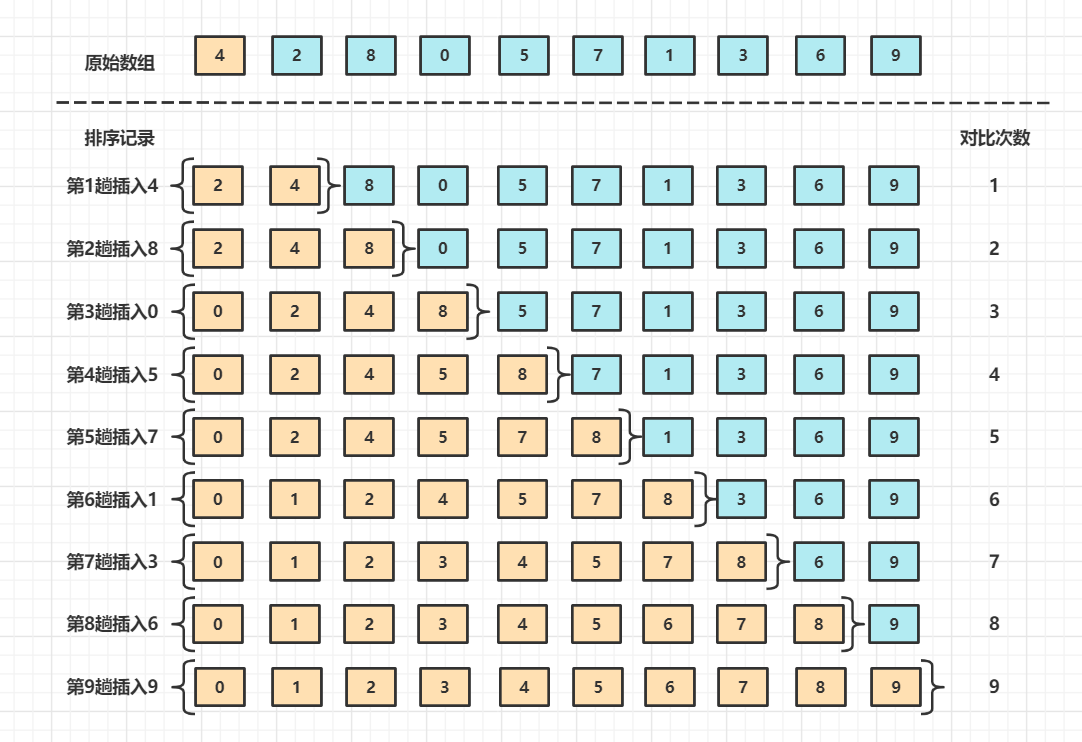插入排序(Insertion Sort)一般也被称为直接插入排序。直接插入排序算法比较简单,容易实现,是一种稳定的排序算法。当待排序元素数量n很小且局部有序时,较为适用
它的基本思想是将一个关键字插入到已经排好序的有序列中,从而得到一个新的、元素数增1的有序列。假设在过程中,元素序列为 R[0…n-1],首先将第一个元素 R[0] 看作一个有序子序列,然后依次将元素 R[i] (1<=i<=n-1)插入有序子序列 R[0…n-1] 中,使元素的有序子序列从 R[0…i-1] 变为 R[0…i]
实现要点
在其实现过程使用双层循环,外层循环对除了第一个元素之外的所有元素,内层循环对当前元素前面有序列进行待插入位置查找,并进行移动
测试用例: 使用插入排序算法将数组 { 4,2,8,0,5,7,1,3,6,9 } 进行升序排序

代码实现
package insertion_sorting;
public class InsertSorting {
public static void main(String[] args) {
InsertSorting insertSorting = new InsertSorting();
int[] arr = new int[]{4,2,8,0,5,7,1,3,6,9};
int[] afterSort = insertSorting.straightSort(arr, arr.length);
long end = System.currentTimeMillis();
System.out.print("排序之后的结果:{");
StringBuffer buffer = new StringBuffer();
for (int i = 0; i < afterSort.length; i++) {
if (i != (afterSort.length-1)){
buffer.append(afterSort[i]+",");
} else buffer.append(afterSort[i]);
}
System.out.println(buffer.toString() + "}");
}
/**
* 直接插入排序
* 最好情况下的时间复杂度为O(n)
* 最坏的情况下的时间复杂度和平均时间复杂度为O(n^2)
* 在直接插入排序的过程中,需要一个元素大小的辅助空间用于存放待插入的元素,因此空间复杂度为O(1)
* @param nums 数组
* @param size 数组大小
* @return 返回排列好的数组
*/
public int[] straightSort(int[] nums, int size){
int position, j; // position为待插入的数据位置
int temp; // 用于存放待比较的值
for (position = 1; position < size; position++) { // 循环遍历数组
temp = nums[position]; // 定义待比较的值
for (j = position - 1; 0 <= j && temp < nums[j]; j--) { // 循环遍历有序列,与temp比较值的大小,一直到数组下标0为止
nums[j+1] = nums[j]; // 将大的元素向后移动,因为第j+1个元素本身就是temp,覆盖的话没有关系
nums[j] = temp; // 将小的替换大的元素的位置
}
}
return nums;
}
}
排序前:
4 2 8 0 5 7 1 3 6 9
排序后:
0 1 2 3 4 5 6 7 8 9
时间复杂度
最好的情况是,初始序列为有序,关键字总比较次数最小值为1 + 2 + 3 + . . . + (n-1),也就是无须后移元素
最坏的情况是,初始序列为有序,关键字总比较次数为最大值1 + 2 + 3 + . . . + ( n ? 1 ) = n ( n ? 1 ) / 2 =
1
2
n
2
\frac{1}{2}n^2
21?n2 -
1
2
n
\frac{1}{2}n
21?n =
∑
i
=
2
n
i
\sum_{i=2}^n i
i=2∑n?i
也就是每个关键字都需要与有序序列的每一个元素比较,时间复杂度为
O
(
n
2
)
O(n^2)
O(n2)
上面那个例子就是最坏的情况下
空间复杂度
在直接插入排序的过程中,只需要一个元素大小的辅助空间用于存放待插入的元素,因此空间复杂度为
O
(
1
)
O(1)
O(1)